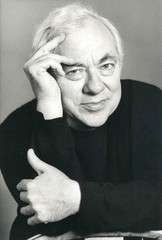|
Back
The Immaculate Curator New York
Isaac Stern Auditorium, Carnegie Hall
05/01/2014 -
Leos Janácek: Selections from On The Overgrown Path, Book I: “A blown-away Leaf”, “Come with us!”, “Our Evenings” & “Good Night!”
Robert Schumann: Davidsbündlertänze, Opus 6
Claude Debussy: Preludes, Book I
Richard Goode (Pianist) 
R. Goode (© Courtesy of the Artist)
Richard Goode produced his own version of “Pictures at an Exhibition” last night. Not the Mussorgsky version, but pictures curated and created by himself, a most elegant of musical painters.
One must imagine a tripartite gallery. The beginning and end chambers contain impressionist pictures from the same era. The middle chamber contains more literal images, somewhat consciously sculptural, yet cut from the same impetus to depict human feelings in tones and rhythms. In Richard Goode, the pictures were framed with that same elegant color and lack of bombast which has characterized a career which has lasted more than half a century.
In the opening gallery were four works by Leos Janácek. Written in the first decade of the Twentieth Century, they were collages. Blurred Daguerrotypes, black-and-white John Burroughs nature pictures of the time with splotches of Jackson Pollack paint thrown at different moments. “Our Evenings” like a dark meeting in a wooden cabin, the door flung open by the wind, then closed again. “A Blown-Again Leaf” the skittering fuzzy image of a leaf into the sky and back again.
Mr. Goode is hardly known as a Janácek interpreter, and those who do play their Janácek might not look sympathetically at his quite literal renderings. Mr. Janáèek actually seemed to distance himself from the images, was almost disinterested.
Yet one must look at the Janácek the way Mr. Goode might have seen it. Perhaps he visualized Janácek, yes, on The Overgrown Path, jotting his notes with sudden instinct. I have no doubt that the composer did work on them, but they seemed like throwaway gems, bagatelles which could be played with that same literalness, to give, not an emotion, but a passing an image (in 2014 terms, an Instagram) of his notions.
In that same decade when Janáèek jotted his feelings, Debussy was producing another set of pictures in his Préludes. These were hardly photographs, nor could they have been written while sitting on a tree branch in a Czech forest. Rather, Debussy roamed the world of imagination. Greek nymphs, Italian mountains, medieval clowns and a cathedral under the water.
This was where Mr. Goode could have romanced the music, gilded the poetic lilies with his own feelings. Like the Janácek works, this is not the most familiar territory for Richard Goode. He needed the score, but there was little doubt that like, like his colleague Mitsuko Uchida, he had studied every note before attempting to play them. His figuration of “Sails” was like a more complex version of Janácek’s leaf. “The Wind in the Plains” surged like an Alabama tornado, yet one has the feeling that nobody was actually on those plains, that the winds were never really dangerous.
Each of the twelve pieces from Book I had its own merit, but I was stunned at the beautiful impression of “The Hills of Anacapri” with its light Italian rhythms, whispered from the Steinway, like sounds heard beyond the hills.
“The Submerged Cathedral” never fails to arouse any audience, but Carnegie Hall had its own addition to the work. A woman behind me had been trying to stifle her coughing, but during “La Cathédrale engloutie”, she let out with some unearthly hacking.
Others looked annoyed and askance, but I had a true sympathy for her. As Mr. Goode plumbed Debussy's watery depths, she, taking the picture too literally, had gulped down a great dollop of salt water. Loud coughs were the anatomical inevitabilities.
The middle gallery was devoted to one of Schumann’s less popular piano series. While Mr. Goode played them with his usual aplomb, one couldn’t help feeling that, next to the opacity of the other composers, these instructions to play “With Inner Feeling”, “Impatiently”. “Wild and Merry”, all within realm of Eusebius and Florestan., would restrain any pianist.
But Mr. Goode has such poise, such an attitude of respect and introspection, that he carried through all 18 pieces with as much honesty as his wonderful fingers could handle.
I confess to having enjoyed the extended encore Schumann Arabesque, without all those literal intricate instructions, far more. As for the Debussy encore, “Ondine”, Mr. Goode again showed that the balance of sensitivity and restraint, can produce an eternally seductive image.
Harry Rolnick
|